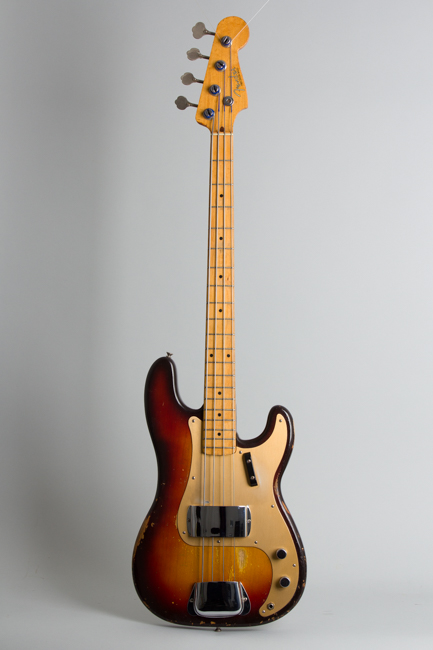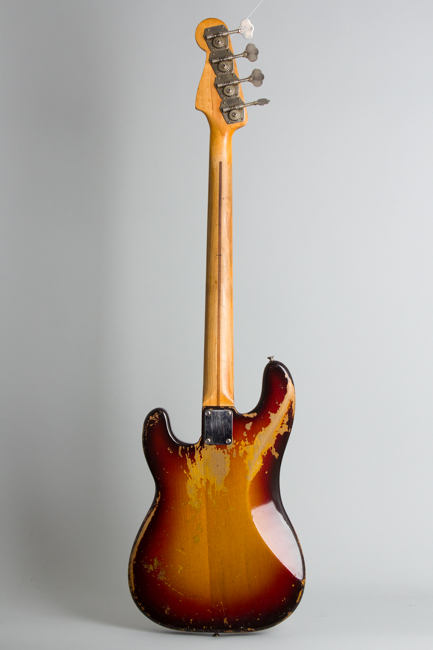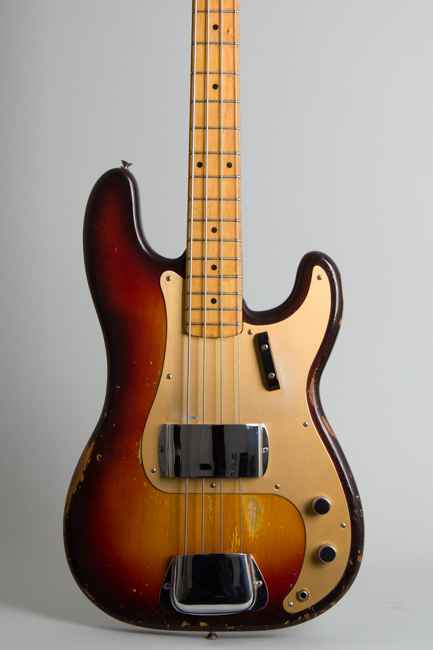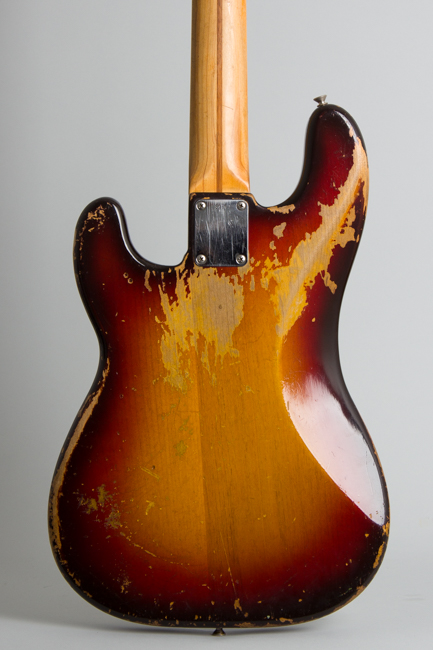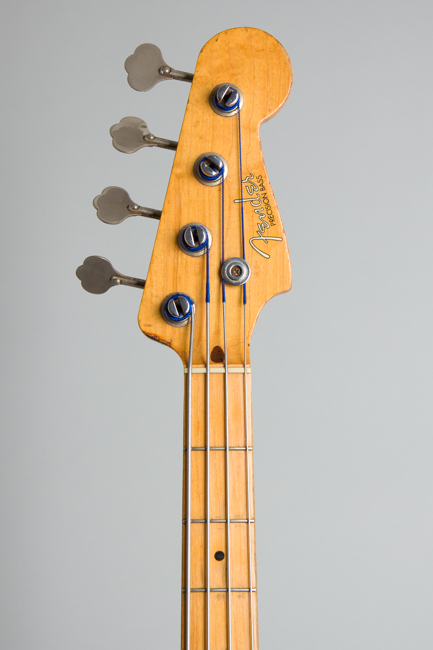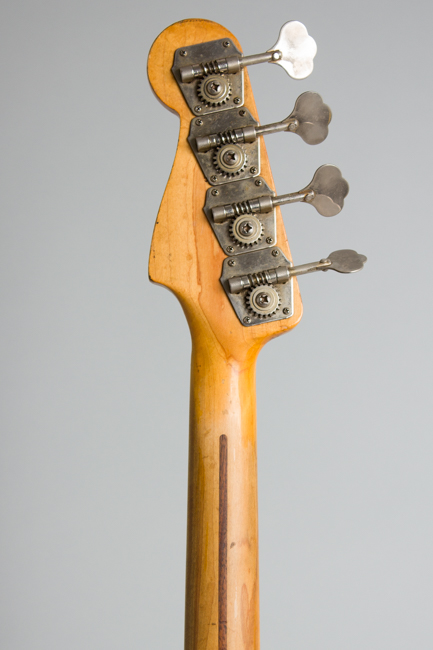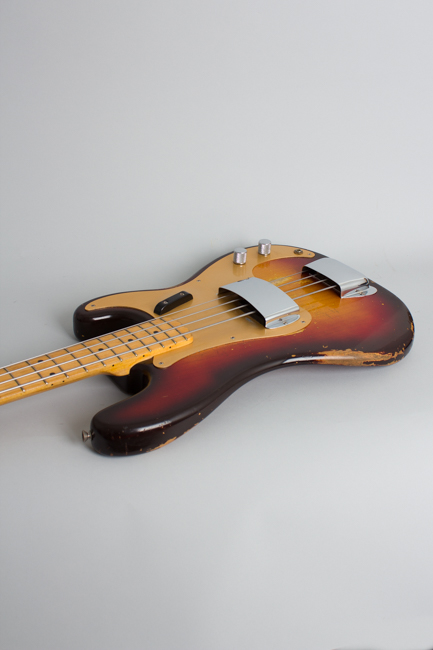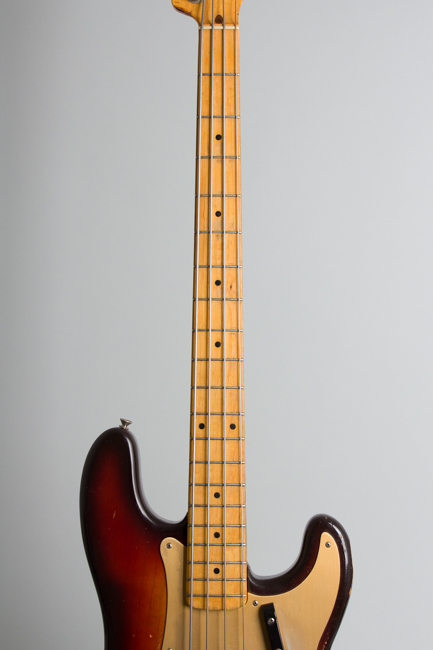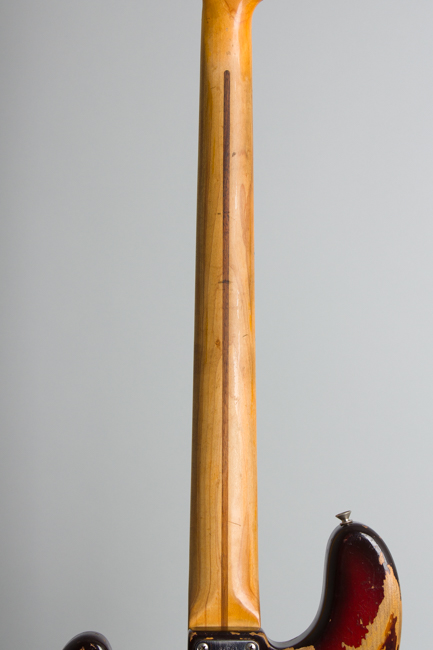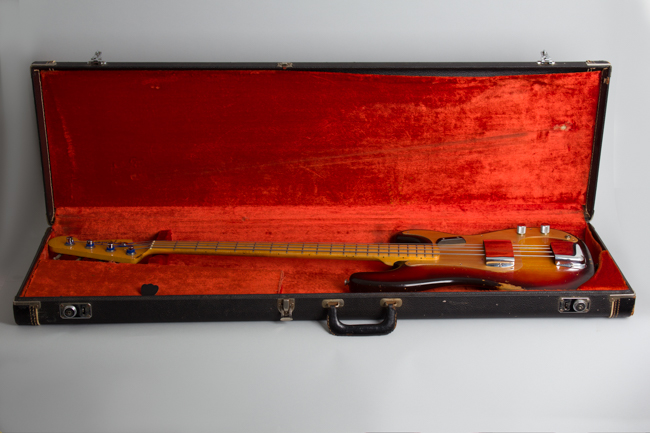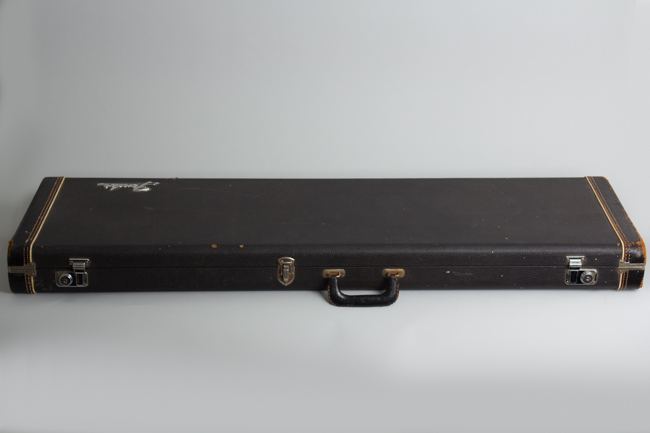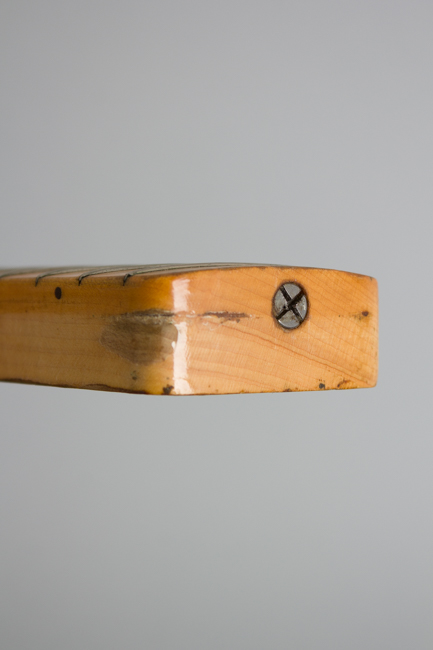Fender Precision Bass Solid Body Electric Bass Guitar (1959)
This item has been sold.
Item # 11080
Prices subject to change without notice.
Fender Precision Bass Model Solid Body Electric Bass Guitar (1959), made in Fullerton, California, sunburst lacquer finish, alder body, maple neck, black tolex hard shell case.
This 1959 Fender Precision Bass is a well-played "Genuine Relic" example of what many players and collectors hold to be the finest electric bass ever made, the template for so many to follow. In mid-1957 the Fender Precision bass was re-designed with these new features: gold anodized aluminum pickguard, split pickup, fully adjustable 4-saddle bridge and a larger "Strat style" headstock on the one-piece maple neck. The deep 3-color sunburst finish was added shortly after. These basses have been sought after since the earliest beginnings of electric instrument collecting, generally regarded some of the most desirable of all Fender basses and the apex of Precision Bass design.
This bass is a played-in but still mostly original example from early/mid 1959. The body is dated 3-59 in the pickup cavity; as with all Fenders from this exact period there is no neck date. It would have been assembled about a year and a half after this updated version went into production and only a few months before the model was altered to receive the new "slab" rosewood fingerboards that summer. The production run for this version of the Precision was only that two-year span; although always popular these basses have never been common! The beautiful gold anodized metal pickguard would last into the late summer of 1959, then replaced by celluloid. The tendency of the metal to wear through was the reason Fender Sales insisted on the change but the "gold guard" has been a status symbol ever since!
The bass carries a lovely three-tone sunburst lacquer finish with plenty of red hue remaining; under the pickguard it is deeper still. The natural-finished neck has a round-backed but quite slim profile. The headstock is adorned with the old "Spaghetti" Fender logo decal, which is in excellent shape. This bass has major Mojo and is an absolute classic, as played by the great majority of the then-new electric bassists of the late 1950s and heard on countless recordings. Even later in the 1960s one of these old maple neck, gold guard basses was often considered a status symbol by the discerning bassist (Amusingly illustrated in the film "That Thing You Do"). It remains a wonderful instrument for any style of music, an absolute joy to play, and a prime example of the ultimate glory days of Fender.
Overall length is 46 in. (116.8 cm.), 13 in. (33 cm.) wide at lower bout, and 1 1/2 in. (3.8 cm.) in depth, measured at side of rim. Scale length is 34 in. (864 mm.). Width of nut is 1 11/16 in. (43 mm.).
This bass shows moderately heavy wear overall but no structural damage or repair only one minor alteration; long ago the pots were changed to high-grade Allen Bradley pots, as favored by (among others) many older Nashville players. As these have a larger "can" than traditional pots there was some very minor enlargement of the control cavity to accommodate them, extremely neatly done. Many of these basses were played for decades and a large proportion of them have lost the original finish entirely; this one is worn but unaltered.
The lacquer has noticeable wear everywhere with a collection of dings, dents and scrapes over most of the instrument. the largest areas worn away are two sizable belt-buckling spots on the back, a deep spot of finger-wear under the strings on the face and some upper body arm wear. The body edges are the heavily marked, as is common, there are two small circular deeper dings into the wood on the back. The neck has some checking on the fingerboard and headstock; the decal is very well preserved. Much of the finish has been worn through to the wood on the back (with that glorious "played-in Fender feel) but there is less lacquer loss to the fingerboard than many. The anodized pickguard has wear in several small spots but remains relatively clean with a very attractive patina.
Internally the bass is original except as noted the pots. Externally the hardware is original except the chrome covers appear more recent, and the screws holding the tailpiece cover are a bit oversize. The original small-wire frets show just some light wear but are quite playable; the very slim maple neck is lovely and straight and plays effortlessly. This bass sounds fantastic and is ready for stage or studio, currently housed in a later vintage Fender hardshell case. Very Good + Condition.
This 1959 Fender Precision Bass is a well-played "Genuine Relic" example of what many players and collectors hold to be the finest electric bass ever made, the template for so many to follow. In mid-1957 the Fender Precision bass was re-designed with these new features: gold anodized aluminum pickguard, split pickup, fully adjustable 4-saddle bridge and a larger "Strat style" headstock on the one-piece maple neck. The deep 3-color sunburst finish was added shortly after. These basses have been sought after since the earliest beginnings of electric instrument collecting, generally regarded some of the most desirable of all Fender basses and the apex of Precision Bass design.
This bass is a played-in but still mostly original example from early/mid 1959. The body is dated 3-59 in the pickup cavity; as with all Fenders from this exact period there is no neck date. It would have been assembled about a year and a half after this updated version went into production and only a few months before the model was altered to receive the new "slab" rosewood fingerboards that summer. The production run for this version of the Precision was only that two-year span; although always popular these basses have never been common! The beautiful gold anodized metal pickguard would last into the late summer of 1959, then replaced by celluloid. The tendency of the metal to wear through was the reason Fender Sales insisted on the change but the "gold guard" has been a status symbol ever since!
The bass carries a lovely three-tone sunburst lacquer finish with plenty of red hue remaining; under the pickguard it is deeper still. The natural-finished neck has a round-backed but quite slim profile. The headstock is adorned with the old "Spaghetti" Fender logo decal, which is in excellent shape. This bass has major Mojo and is an absolute classic, as played by the great majority of the then-new electric bassists of the late 1950s and heard on countless recordings. Even later in the 1960s one of these old maple neck, gold guard basses was often considered a status symbol by the discerning bassist (Amusingly illustrated in the film "That Thing You Do"). It remains a wonderful instrument for any style of music, an absolute joy to play, and a prime example of the ultimate glory days of Fender.
Overall length is 46 in. (116.8 cm.), 13 in. (33 cm.) wide at lower bout, and 1 1/2 in. (3.8 cm.) in depth, measured at side of rim. Scale length is 34 in. (864 mm.). Width of nut is 1 11/16 in. (43 mm.).
This bass shows moderately heavy wear overall but no structural damage or repair only one minor alteration; long ago the pots were changed to high-grade Allen Bradley pots, as favored by (among others) many older Nashville players. As these have a larger "can" than traditional pots there was some very minor enlargement of the control cavity to accommodate them, extremely neatly done. Many of these basses were played for decades and a large proportion of them have lost the original finish entirely; this one is worn but unaltered.
The lacquer has noticeable wear everywhere with a collection of dings, dents and scrapes over most of the instrument. the largest areas worn away are two sizable belt-buckling spots on the back, a deep spot of finger-wear under the strings on the face and some upper body arm wear. The body edges are the heavily marked, as is common, there are two small circular deeper dings into the wood on the back. The neck has some checking on the fingerboard and headstock; the decal is very well preserved. Much of the finish has been worn through to the wood on the back (with that glorious "played-in Fender feel) but there is less lacquer loss to the fingerboard than many. The anodized pickguard has wear in several small spots but remains relatively clean with a very attractive patina.
Internally the bass is original except as noted the pots. Externally the hardware is original except the chrome covers appear more recent, and the screws holding the tailpiece cover are a bit oversize. The original small-wire frets show just some light wear but are quite playable; the very slim maple neck is lovely and straight and plays effortlessly. This bass sounds fantastic and is ready for stage or studio, currently housed in a later vintage Fender hardshell case. Very Good + Condition.
